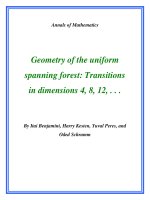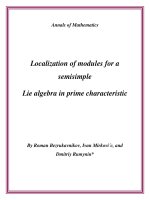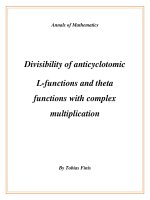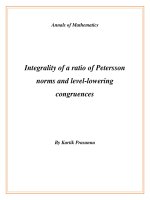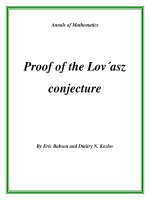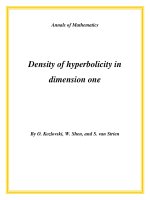Đề tài "Annals of Mathematics Lehmer’s problem for polynomials with odd coefficients " pptx
Bạn đang xem bản rút gọn của tài liệu. Xem và tải ngay bản đầy đủ của tài liệu tại đây (204.06 KB, 21 trang )
Annals of Mathematics
Lehmer’s problem for
polynomials with odd
coefficients
By Peter Borwein, Edward Dobrowolski, and
Michael J. Mossinghoff*
Annals of Mathematics, 166 (2007), 347–366
Lehmer’s problem for polynomials
with odd coefficients
By Peter Borwein, Edward Dobrowolski, and Michael J. Mossinghoff*
Abstract
We prove that if f(x)=
n−1
k=0
a
k
x
k
is a polynomial with no cyclotomic
factors whose coefficients satisfy a
k
≡ 1 mod 2 for 0 ≤ k<n, then Mahler’s
measure of f satisfies
log M(f) ≥
log 5
4
1 −
1
n
.
This resolves a problem of D. H. Lehmer [12] for the class of polynomials with
odd coefficients. We also prove that if f has odd coefficients, degree n−1, and
at least one noncyclotomic factor, then at least one root α of f satisfies
|α| > 1+
log 3
2n
,
resolving a conjecture of Schinzel and Zassenhaus [21] for this class of poly-
nomials. More generally, we solve the problems of Lehmer and Schinzel and
Zassenhaus for the class of polynomials where each coefficient satisfies a
k
≡ 1
mod m for a fixed integer m ≥ 2. We also characterize the polynomials that
appear as the noncyclotomic part of a polynomial whose coefficients satisfy
a
k
≡ 1modp for each k, for a fixed prime p. Last, we prove that the smallest
Pisot number whose minimal polynomial has odd coefficients is a limit point,
from both sides, of Salem [19] numbers whose minimal polynomials have coef-
ficients in {−1, 1}.
1. Introduction
Mahler’s measure of a polynomial f, denoted M(f), is defined as the
product of the absolute values of those roots of f that lie outside the unit disk,
multiplied by the absolute value of the leading coefficient. Writing f(x)=
*The first author was supported in part by NSERC of Canada and MITACS. The
authors thank the Banff International Research Station for hosting the workshop on “The
many aspects of Mahler’s measure,” where this research began.
348 P. BORWEIN, E. DOBROWOLSKI, AND M. J. MOSSINGHOFF
a
d
k=1
(x − α
k
), we have
M(f)=|a|
d
k=1
max{1, |α
k
|}.(1.1)
For f ∈ Z[x], clearly M(f) ≥ 1, and by a classical theorem of Kronecker,
M(f) = 1 precisely when f(x) is a product of cyclotomic polynomials and the
monomial x. In 1933, D. H. Lehmer [12] asked if for every ε>0 there exists a
polynomial f ∈ Z[x] satisfying 1 < M(f) < 1+ε. This is known as Lehmer’s
problem. Lehmer noted that the polynomial
(x)=x
10
+ x
9
− x
7
− x
6
− x
5
− x
4
− x
3
+ x +1
has M()=1.176280 , and this value remains the smallest known measure
larger than 1 of a polynomial with integer coefficients.
Let f
∗
denote the reciprocal polynomial of f, defined by f
∗
(x)=
x
deg f
f(1/x); it is easy to verify that M(f
∗
)=M(f). We say a polynomial
f is reciprocal if f = ±f
∗
.
Lehmer’s problem has been solved for several special classes of polyno-
mials. For example, Smyth [22] showed that if f ∈ Z[x] is nonreciprocal and
f(0) = 0, then M(f) ≥ M(x
3
−x−1) = 1.324717 . Also, Schinzel [20] proved
that if f is a monic, integer polynomial with degree d satisfying f(0) = ±1
and f(±1) = 0, and all roots of f are real, then M(f) ≥ γ
d/2
, where γ denotes
the golden ratio, γ =(1+
√
5)/2. In addition, Amoroso and Dvornicich [1]
showed that if f is an irreducible, noncyclotomic polynomial of degree d whose
splitting field is an abelian extension of Q, then M(f) ≥ 5
d/12
.
The best general lower bound for Mahler’s measure of an irreducible, non-
cyclotomic polynomial f ∈ Z[x] with degree d has the form
log M(f)
log log d
log d
3
;
see [6] or [8].
In this paper, we solve Lehmer’s problem for another class of polynomials.
Let D
m
denote the set of polynomials whose coefficients are all congruent to 1
mod m,
D
m
=
d
k=0
a
k
x
k
∈ Z[x]:a
k
≡ 1modm for 0 ≤ k ≤ d
.(1.2)
The set D
2
thus contains the set of Littlewood polynomials, defined as those
polynomials f whose coefficients a
k
satisfy a
k
= ±1 for 0 ≤ k ≤ deg f .We
prove in Corollaries 3.4 and 3.5 of Theorem 3.3 that if f ∈D
m
has degree n−1
LEHMER’S PROBLEM FOR POLYNOMIALS WITH ODD COEFFICIENTS
349
and no cyclotomic factors, then
log M(f) ≥ c
m
1 −
1
n
,
with c
2
= (log 5)/4 and c
m
= log(
√
m
2
+1/2) for m>2.
We provide in Theorem 2.4 a characterization of polynomials f ∈ Z[x] for
which there exists a polynomial F ∈D
p
with f | F and M(f)=M(F ), where
p is a prime number. The proof in fact specifies an explicit construction for
such a polynomial F when it exists.
In [21], Schinzel and Zassenhaus conjectured that there exists a constant
c>0 such that for any monic, irreducible polynomial f of degree d, there exists
arootα of f satisfying |α| > 1+c/d. Certainly, solving Lehmer’s problem
resolves this conjecture as well: If M(f) ≥ M
0
for every member f of a class
of monic, irreducible polynomials, then it is easy to see that the conjecture of
Schinzel and Zassenhaus holds for this class with c = log M
0
. We prove some
further results on this conjecture for polynomials in D
m
. In Theorem 5.1, we
show that if f ∈D
m
is monic with degree n−1 and M(f) > 1, then there exists
arootα of f satisfying |α| > 1+c
m
/n, with c
2
= log
√
3 and c
m
= log(m −1)
for m>2. We also prove (Theorem 5.3) that one cannot replace the constant
c
m
in this result with any number larger than log(2m − 1).
Recall that a Pisot number is a real algebraic integer α>1, all of whose
conjugates lie inside the open unit disk, and a Salem number is a real algebraic
integer α>1, all of whose conjugates lie inside the closed unit disk, with at
least one conjugate on the unit circle. (In fact, all the conjugates of a Salem
number except its reciprocal lie on the unit circle.) In Theorem 6.1, we obtain
a lower bound on a Salem number whose minimal polynomial lies in D
2
. This
bound is slightly stronger than that obtained from our bound on Mahler’s
measure of a polynomial in this set.
The smallest Pisot number is the minimal value of Mahler’s measure of a
nonreciprocal polynomial, M(x
3
− x − 1) = 1.324717 . In [4], it is shown
that the smallest measure of a nonreciprocal polynomial in D
2
is the golden
ratio, M(x
2
−x −1) = γ, and therefore this value is the smallest Pisot number
whose minimal polynomial lies in D
2
. Salem [19] proved that every Pisot
number is a limit point, from both sides, of Salem numbers. We prove in
Theorem 6.2 that the golden ratio is in fact a limit point, from both sides, of
Salem numbers whose minimal polynomials are also in D
2
; in fact, they are
Littlewood polynomials.
This paper is organized as follows. Section 2 obtains some preliminary
results on factors of cyclotomic polynomials modulo a prime, and describes
factors of polynomials in D
p
. Section 3 derives our results on Lehmer’s problem
for polynomials in D
m
. The method here requires the use of an auxiliary
polynomial, and Section 4 describes two methods for searching for favorable
auxiliary polynomials in a particularly promising family. Section 5 proves our
350 P. BORWEIN, E. DOBROWOLSKI, AND M. J. MOSSINGHOFF
bounds in the problem of Schinzel and Zassenhaus for polynomials in D
m
, and
Section 6 contains our results on Salem numbers whose minimal polynomials
are in D
2
.
Throughout this paper, the nth cyclotomic polynomial is denoted by Φ
n
.
Also, for a polynomial f(x)=
d
k=0
a
k
x
k
, the length of f, denoted L(f), is
defined as the sum of the absolute values of the coefficients of f,
L(f)=
d
k=0
|a
k
|,(1.3)
and f
∞
denotes the supremum of |f(x)| over the unit circle.
2. Factors of polynomials in D
p
Let p be a prime number. We describe some facts about factors of cyclo-
tomic polynomials modulo p, and then prove some results about cyclotomic
and noncyclotomic parts of polynomials whose coefficients are all congruent
to1modp. We begin by recording a factorization of the binomial x
n
− 1
modulo p.
Lemma 2.1. Suppose p is a prime number, and n = p
k
m with p m.
Then
x
n
− 1 ≡
d|m
Φ
p
k
d
(x)modp.
Proof. Using the standard formula Φ
n
(x)=
d|n
x
d
− 1
μ(n/d)
, where
μ(·) denotes the M¨obius function, one obtains the well-known relations
Φ
pq
(x)=
⎧
⎪
⎨
⎪
⎩
Φ
q
(x
p
), if p | q,
Φ
q
(x
p
)
Φ
q
(x)
, if p q.
Thus, if n = p
k
m with p m, then Φ
n
(x) ≡ Φ
ϕ(p
k
)
m
(x)modp, where ϕ(·)
denotes Euler’s totient function. Therefore,
x
n
− 1=
d|n
Φ
d
(x) ≡
d|m
Φ
k
i=0
ϕ(p
i
)
d
(x)=
d|m
Φ
p
k
d
(x)modp,
establishing the result.
Let F
p
denote the field with p elements, where p is a prime number. Cyclo-
tomic polynomials are of course irreducible in Q[x], but this is not necessarily
the case in F
p
[x]. However, cyclotomic polynomials whose indices are relatively
prime and not divisible by p have no common factors in F
p
[x].
LEHMER’S PROBLEM FOR POLYNOMIALS WITH ODD COEFFICIENTS
351
Lemma 2.2. Suppose m and n are distinct, relatively prime positive inte-
gers, and suppose p is a prime number that does not divide mn. Then Φ
n
(x)
and Φ
m
(x) are relatively prime in F
p
[x].
Proof. Let e denote the multiplicative order of p modulo n.InF
p
[x], the
polynomial Φ
n
(x) factors as the product of all monic irreducible polynomials
with degree e and order n (see [13, Ch. 3]). Since their factors in F
p
[x] have
different orders, we conclude that Φ
n
and Φ
m
are relatively prime modulo p.
We next describe the cyclotomic factors that may appear in a polynomial
whose coefficients are all congruent to 1 modulo p.
Lemma 2.3. Suppose f(x) ∈ Z[x] has degree n −1 and Φ
r
| f.Iff ∈D
2
,
then r | 2n; if f ∈D
p
for an odd prime p, then r | n.
Proof. Suppose f ∈D
p
with p prime. Write n = p
k
m with p m.By
Lemma 2.1, we have
(x − 1)f(x) ≡
d|m
Φ
p
k
d
(x)modp.(2.1)
Write r = p
l
s with p s.Ifl = 0, then in view of Lemma 2.2, the polynomial
Φ
r
must appear among the factors Φ
d
on the right side of (2.1), so that r | m.
If l>0, then Φ
r
≡ Φ
ϕ(p
l
)
s
mod p,sos | m.Ifs>1 then we also have
p
k
≥ p
l
−p
l−1
, and so if p>2 then k ≥ l and thus r | n;ifp = 2 then k ≥ l −1
and consequently r | 2n. Last, if s = 1 then p
k
≥ p
l
− p
l−1
+ 1 and thus k ≥ l
and r | n.
We now state a simple characterization of polynomials f ∈ Z[x] that divide
a polynomial with the same measure having all its coefficients congruent to 1
modulo p.
Theorem 2.4. Let p be a prime number, and let f(x) be a polynomial
with integer coefficients. There exists a polynomial F ∈D
p
with f | F and
M(f)=M(F) if and only if f is congruent modulo p to a product of cyclotomic
polynomials.
Proof. Suppose first that F ∈D
p
factors as F (x)=f(x)Φ(x) with M(Φ)=1,
so that Φ(x) is a product of cyclotomic polynomials. Since F ∈D
p
,itis
congruent modulo p to a product of cyclotomic polynomials. Using Lemma 2.2
and the fact that F
p
[x] is a unique factorization domain, we conclude that the
polynomial f must also be congruent modulo p to a product of cyclotomic
polynomials.
352 P. BORWEIN, E. DOBROWOLSKI, AND M. J. MOSSINGHOFF
For the converse, suppose
f(x) ≡
p
d
Φ
e
d
d
(x)modp,
with each e
d
≥ 0. Let k =
log
p
(max{e
1
+1, max{e
d
: d>1,p d}})
, m =
lcm{d : e
d
> 0,p d}, n = mp
k
+ 1, and
Φ(x)=(x − 1)
p
k
−e
1
−1
d|m
d>1
Φ
p
k
−e
d
d
(x).
Then
(x − 1)f(x)Φ(x) ≡
d|m
Φ
p
k
d
(x) ≡ x
n
− 1modp,
and so F (x)=f(x)Φ(x) has the required properties.
Theorem 2.4 suggests an algorithm for determining if a given polynomial f
with degree d divides a polynomial F in D
p
with the same measure: Construct
all possible products of cyclotomic polynomials with degree d, and test if any of
these are congruent to f mod p. Using this strategy, we verify that none of the
100 irreducible, noncyclotomic polynomials from [15] representing the smallest
known values of Mahler’s measure divides a Littlewood polynomial with the
same measure. This does not imply, however, that no Littlewood polynomi-
als exist with these measures, since measures are not necessarily represented
uniquely by irreducible integer polynomials, even discounting the simple sym-
metries M(f)=M(±f(±x
k
)). See [7] for more information on the values of
Mahler’s measure.
The requirement in Theorem 2.4 that F(x) contain no noncyclotomic fac-
tors besides f is certainly necessary. For example, the polynomial x
10
− x
7
−
x
5
−x
3
+1 is not congruent to a product of cyclotomic polynomials mod 2, so no
Littlewood polynomial exists having this polynomial as its only noncyclotomic
factor. However, the product (x
10
−x
7
−x
5
−x
3
+ 1)(x
10
−x
9
+ x
5
−x +1) is
congruent to Φ
33
mod 2, and our construction indicates that multiplying this
product by Φ
1
Φ
2
3
Φ
2
11
Φ
33
yields a polynomial with all odd coefficients. (In fact,
using the factors Φ
2
Φ
3
Φ
6
Φ
33
Φ
44
instead yields a Littlewood polynomial.)
We close this section by noting that one may demand stronger conditions
on the polynomial F of Theorem 2.4 in certain situations.
Corollary 2.5. Suppose f ∈ Z[x] has no cyclotomic factors, and there
exists a polynomial F ∈D
2
with even degree 2m having f | F and M(f)=
M(F ). Then there exists a polynomial G ∈D
2
with deg G =2m, f | G,
M(f)=M(G), and the additional property that G(x) and 1+x+x
2
+···+x
2m
have no common factors.
LEHMER’S PROBLEM FOR POLYNOMIALS WITH ODD COEFFICIENTS
353
Proof. Suppose Φ
d
| F . By Lemma 2.3, we have d | (4m + 2). If d is odd
and d ≥ 3, so that Φ
d
(x) is a factor of 1 + x + ···+ x
2m
, then we can replace
the factor Φ
d
in F with Φ
2d
without disturbing the required properties of F ,
since Φ
2d
(x)=Φ
d
(−x). Let G be the polynomial obtained from F by making
this substitution for each factor Φ
d
of F with d ≥ 3 odd.
3. Lehmer’s problem
We derive a lower bound on Mahler’s measure of a polynomial that has no
cyclotomic factors and whose coefficients are all congruent to 1 modulo m for
some fixed integer m ≥ 2. Our results depend on the bounds on the resultants
appearing in the following lemma.
Lemma 3.1. Suppose f ∈D
m
with degree n−1, and let g be a factor of f .
If gcd(g(x),x
n
− 1) = 1, then
|Res(g(x),x
n
− 1)|≥m
deg g
.(3.1)
Further, if m =2,k is a nonnegative integer, and gcd(g(x),x
n2
k
+1)=1,then
Res(g(x),x
n2
k
+1)
≥ 2
deg g
.(3.2)
Proof. Define the polynomial s(x)by
ms(x)=(x
n
− 1)+(1− x)f(x),(3.3)
and note that s(x) ∈ Z[x] since f ∈D
m
.Ifg has no common factor with x
n
−1,
then gcd(g, s) = 1, so |Res(g, s)|≥1. Thus, by computing the resultant of both
sides of (3.3) with g, we obtain (3.1).
Suppose m =2. Fork ≥ 0, define the polynomial t
k
(x)by
2t
k
(x)=(x
n2
k
+1)+(1+x)f(x)
2
k
−1
j=0
x
jn
.
Now, (3.2) follows by a similar argument.
We also require the following result regarding the length of a power of a
polynomial.
Lemma 3.2. For any polynomial f ∈ C[x], the value of L(f
k
)
1/k
ap-
proaches f
∞
from above as k →∞.
Proof. From the triangle and Cauchy-Schwarz inequalities, we have
f
k
∞
≤ L(f
k
) ≤
√
1+k deg f
f
k
∞
, and since
f
k
∞
= f
k
∞
, the result follows
immediately.
354 P. BORWEIN, E. DOBROWOLSKI, AND M. J. MOSSINGHOFF
Our main theorem in this section provides a lower bound on the measure
of a polynomial in D
m
that depends on certain properties of an auxiliary
polynomial. For a polynomial g ∈ Z[x], let ν
k
(g) denote the multiplicity of
the cyclotomic polynomial Φ
2
k
(x)ing(x), and let ν(g)=
k≥0
ν
k
(g).
Theorem 3.3. Suppose f ∈D
m
with degree n −1, and suppose F ∈ Z[x]
satisfies gcd(f(x),F(x
n
)) = 1. Then
log M(f) ≥
⎧
⎪
⎪
⎨
⎪
⎪
⎩
ν(F ) log 2 − log F
∞
deg F
1 −
1
n
, if m =2,
ν
0
(F ) log m −log F
∞
deg F
1 −
1
n
, if m>2.
Proof. Suppose m = 2. Since f(x) and F (x
n
) have no common factors,
by Lemma 3.1 each cyclotomic factor Φ
2
k
of F contributes a factor of 2
n−1
to
their resultant. Thus
|Res(f(x),F(x
n
))|≥2
ν(F )(n−1)
.
If α isarootoff, then
|F (α
n
)|≤L(F ) max
1, |α|
n deg F
,
so that
|Res(f(x),F(x
n
))|≤L(F )
n−1
M(f)
n deg F
.
Therefore
2
ν(F )(n−1)
≤ L(F )
n−1
M(f)
n deg F
,
or
log M(f) ≥
ν(F ) log 2 − log L(F )
deg F
1 −
1
n
.(3.4)
Let k be a positive integer. Since ν(F
k
)=kν(F ) and deg F
k
= k deg F ,we
obtain
log M(f) ≥
ν(F ) log m − log L(F
k
)
1/k
deg F
1 −
1
n
.
The theorem follows by letting k →∞and using Lemma 3.2. The proof for
m>2 is similar, with ν
0
(F ) in place of ν(F ).
For example, if f has all odd coefficients and no cyclotomic factors, then
we may use F (x)=x
2
− 1 in Theorem 3.3 to obtain
log M(f) ≥
log 2
2
1 −
1
n
.(3.5)
LEHMER’S PROBLEM FOR POLYNOMIALS WITH ODD COEFFICIENTS
355
For m>2, if f ∈D
m
has no cyclotomic factors, then we may use F (x)=x −1
to obtain
log M(f) ≥ log(m/2)
1 −
1
n
.(3.6)
Section 4 describes a class of polynomials that one might expect to contain
some choices for F that improve the bounds (3.5) and (3.6), and describes some
algorithms developed to search this set for better auxiliary polynomials. We
record here some improved bounds that arose from these searches.
Corollary 3.4. Let f be a polynomial with degree n −1 having odd co-
efficients and no cyclotomic factors. Then
log M(f) ≥
log 5
4
1 −
1
n
,(3.7)
with equality if and only if f(x)=±1.
Proof. Let F (x)=
1+x
2
1 − x
2
4
. Since ν(F ) = 9, deg F = 10, and
F
∞
=
(1 + y)(1 − y)
4
∞
=2
5
max
0≤t≤1
cos(πt) sin
4
(πt)
=
2
9
25
√
5
,
using Theorem 3.3 we establish (3.7). Last, if the leading or constant coefficient
of f is greater than 1 in absolute value, then M(f) ≥ 3; if n>1 and these
coefficients are ±1, then M(f) is a unit.
Another auxiliary polynomial yielding the lower bound (3.7) appears in
Section 4.
We remark that the bound of 5
1/4
=1.495348 is not far from the
smallest known measure of a polynomial with odd coefficients and no cyclo-
tomic factors: M(1 + x −x
2
−x
3
−x
4
+ x
5
+ x
6
)=1.556030 . This number
is in fact the smallest measure of a reciprocal polynomial with ±1 coefficients
having no cyclotomic factors and degree at most 72; see [4]. Section 6 provides
more information on the structure of known small values of Mahler’s measure
of these polynomials.
For the case m>2, an auxiliary polynomial similar to the one employed
in Corollary 3.4 improves (3.6) slightly.
Corollary 3.5. Let f ∈D
m
have degree n−1 and no cyclotomic factors.
Then
log M(f) ≥ log
√
m
2
+1
2
1 −
1
n
,(3.8)
with equality if and only if f(x)=±1.
356 P. BORWEIN, E. DOBROWOLSKI, AND M. J. MOSSINGHOFF
Proof. Let F (x)=(1+x)(1−x)
m
2
. Since ν
0
(F )=m
2
, deg F = m
2
+1,
and
F
∞
=2
m
2
+1
max
0≤t≤1
cos(πt) sin
m
2
(πt)
=
2
m
2
+1
m
m
2
(m
2
+1)
(m
2
+1)/2
,
using Theorem 3.3 we verify (3.8). The argument for the case of equality is
similar to that of Corollary 3.4.
Section 4.3 shows that the bound of
√
10/2=1.581138 for m = 3 may
be replaced by 1.582495 by using the auxiliary polynomial
(1 − x)
425
(1 − x
2
)
50
(1 − x
5
).
No improvements are known for m>3.
4. Auxiliary polynomials
We obtain nontrivial bounds on the measure of a polynomial f ∈D
m
from Theorem 3.3 by using auxiliary polynomials having small degree, small
supremum norm, and a high order of vanishing at 1. In this section, we inves-
tigate a family of polynomials having precisely these properties and search for
auxiliary polynomials yielding good lower bounds.
4.1. Pure product polynomials. A pure product of size n is a polynomial
of the form
n
k=1
(1 − x
e
k
) ,
with each e
k
a positive integer. Let A(n) denote the minimal supremum over
the unit disk among all pure products of size n,
A(n) = min
n
k=1
(1 − x
e
k
)
∞
: e
k
≥ 1 for 1 ≤ k ≤ n
.
Erd˝os and Szekeres studied this quantity in [10], proving that the growth rate
of A(n) is subexponential:
lim
n→∞
A(n)
1/n
=1.
The upper bound on the asymptotic growth rate of log A(n) has since been
greatly improved. Atkinson [2] obtained O(
√
n log n), Odlyzko [17] proved
O(n
1/3
log
4/3
n), Kolountzakis [11] demonstrated O(n
1/3
log n), and Belov and
Konyagin [3] showed O(log
4
n). The best known general lower bound on A(n)
LEHMER’S PROBLEM FOR POLYNOMIALS WITH ODD COEFFICIENTS
357
is simply
√
2n; strengthening this would provide information on the Diophan-
tine problem of Prouhet, Tarry, and Escott (see for instance [14]). Erd˝os
conjectured [9, p. 55] that in fact A(n) n
c
for any c>0.
Since ν
0
(A(n)) = n and log A(n)=o(n), it follows that there exist pure
product polynomials F (x) that yield nontrivial lower bounds in Theorem 3.3.
The article [5] exhibits some pure products of size n ≤ 20 with very small
length and degree, and these polynomials yield nontrivial lower bounds in
Theorem 3.3. However, these polynomials arise as optimal examples of poly-
nomials with {−1, 0, 1} coefficients having a root of prescribed order n at 1 and
minimal degree. We obtain better bounds by designing some more specialized
searches. We describe two such searches.
4.2. Hill-climbing. Our first method employs a modified hill-climbing
strategy to search for good auxiliary polynomials F (x), replacing the objective
function appearing in Theorem 3.3 with the computationally more attractive
function from (3.4). So for each m we wish to find large values of
B
m
(F )=
⎧
⎪
⎨
⎪
⎩
ν(F ) log 2 − log L(F )
deg F
, if m =2,
ν
0
(F ) log m −log L(F )
deg F
, if m>2.
Algorithm 4.1. Modified hill-climbing for auxiliary polynomials.
Input. An integer m ≥ 2, a set E of positive integers, and for each e ∈ E,
a nonnegative integer r
e
.
Output. A sequence of pure products {F
k
} with F
k−1
| F
k
for each k.
Step 1. Let F
0
(x)=
e∈E
(1 − x
e
)
r
e
, let b
0
= B
m
(F
0
), and set k =1.
Step 2. For each e ∈ E, compute B
m
((1−x
e
)F
k−1
(x)). If the largest of these
|E| values is greater than b
k−1
, then set F
k
(x)=(1−x
e
)F
k−1
(x) for
the optimal choice of e, set b
k
= B
m
(F
k
), print F
k
and b
k
, increment
k, and repeat Step 2. Otherwise, continue with Step 3.
Step 3. For each subset {e
1
,e
2
} of E, compute B
m
((1−x
e
1
)(1−x
e
2
)F
k−1
(x)).
If the largest of these
|E|
2
values exceeds b
k−1
, then set F
k
(x)=
(1 − x
e
1
)(1 − x
e
2
)F
k−1
(x) for the optimal choice {e
1
,e
2
}, set b
k
=
B
m
(F
k
), print F
k
and b
k
, increment k, and repeat Step 3. Otherwise,
set b
k−1
= 0 and perform Step 2.
Several criteria may be used for termination, for example, a prescribed
bound on k or deg F
k
, or the appearance of a decreasing sequence of values of
b
k
of a particular length.
358 P. BORWEIN, E. DOBROWOLSKI, AND M. J. MOSSINGHOFF
We remark that a pure hill-climbing method would omit the resetting of
b
k−1
to 0 at the end of Step 3 and would terminate as soon as none of the
adjustments of Steps 2 or 3 improves the bound. By adding this assignment,
we need not stop at local maxima and instead allow our objective value to
decrease temporarily in order to continue searching for better values.
We use the revolving door algorithm [16] to enumerate the
|E|
2
combi-
nations of factors to test in Step 3. This way, each polynomial we test can be
constructed from the previous polynomial considered with just one division by
a binomial and one multiplication.
We implemented Algorithm 4.1 in C++ and ran it on an Apple Pow-
erPC G4. For m = 2, letting F
0
(x)=1− x
2
and choosing E to be a set of
small positive integers like {1, 2, ,8}, we see that Algorithm 4.1 produces
a sequence of polynomials of the form (1 − x
2
)
a
(1 − x
4
)
b
with a ≈ 3b. This
suggests the sequence F
k
(x) = ((1 − x
2
)
3
(1 − x
4
))
k
and hence Corollary 3.4.
Despite several variations on the initial values, no better sequence was found
with Algorithm 4.1 for m =2.
For several values of m greater than 2, Algorithm 4.1, starting with
F
0
(x)=1− x, produces a sequence of auxiliary polynomials of the form
(1 − x)
a
(1 − x
2
)
b
with a ≈ (m
2
− 1)b, suggesting the polynomial employed
in Corollary 3.5. Our method also indicates a further improvement for the
case m = 3. With E = {1, 2, 3, 4, 5}, Algorithm 4.1 constructs the polynomial
F (x)=(1− x)
1078
(1 − x
2
)
127
(1 − x
5
)
3
,(4.1)
which has B
3
(F )=1.581983 >
√
10/2. This example is investigated further
in our second search method.
4.3. Special families. A second method of searching for good auxiliary
polynomials in Theorem 3.3 computes F
∞
directly for certain families of pure
products rather than using the quantity L(F ) as a bound. For a polynomial
F , let β
m
(F ) denote the expression appearing in Theorem 3.3:
β
m
(F )=
⎧
⎪
⎨
⎪
⎩
ν(F ) log 2 − log F
∞
deg F
, if m =2,
ν
0
(F ) log m −log F
∞
deg F
, if m>2.
Given m and fixing a set of positive integers E, we evaluate
β
m
e∈E
(1 − x
e
)
r
e
for a number of selections for the exponents r
e
, subject to gcd{r
e
: e ∈ E} =1.
For example, for m = 2 and E = {2, 4, 8}, we find no polynomials that yield
a bound as good as that of Corollary 3.4. However, using E = {2, 4, 6},
LEHMER’S PROBLEM FOR POLYNOMIALS WITH ODD COEFFICIENTS
359
20 40 60 80 100
0.4012
0.4014
0.4016
0.4018
0.4020
0.4022
Figure 1: β
2
(G
k
) for k ≤ 100.
we detect an auxiliary polynomial that does just as well. After computing
β
2
((1 − x
2
)
a
(1 − x
4
)
b
(1 − x
6
)) for 1 ≤ a, b ≤ 50, we find that the polynomials
G
k
(x)=
1 − x
2
2k+1
1 − x
4
k
1 − x
6
produce values rather close to (log 5)/4, and further that these values are
increasing in k over this range. We obtain Figure 1 by computing β
2
for
additional polynomials in this sequence. The maximum value occurs at k = 34,
and
G
34
∞
=
(1 − y)
104
(1 + y)
34
(1 + y + y
2
)
∞
=2
138
max
0≤t≤1
sin
104
(πt) cos
34
(πt)(2 cos(2πt)+1)
=
2
242
5
70
.
Since ν(G
34
) = 242 and deg G
34
= 280, we again obtain (3.7).
For m = 3, given (4.1) we investigate polynomials with E = {1, 2, 5} and
find that we obtain good bounds using r
1
≈ 8.5r
2
and r
3
= 1. The maximum
value of β
3
((1 − x)
17k
(1 − x
2
)
2k
(1 − x
5
)) occurs at k = 25, yielding the value
1.582495 cited at the end of Section 3.
Similar investigations for larger values of m have not improved the bound
of Corollary 3.5. For example, choosing E = {1, 2, 5}, r
1
=(2m
2
−1)k, r
2
=2k,
k ≥ 1, and r
3
= 1, we obtain a sequence of values under β
m
approaching
log(
√
m
2
+1/2) from below, but no polynomial tested improves this bound.
5. The conjecture of Schinzel and Zassenhaus
The lower bounds on log M(f) for f ∈D
m
of Corollaries 3.4 and 3.5
automatically yield lower bounds on max{|α| : f(α)=0} for polynomials f ∈
D
m
having no cyclotomic factors. The following theorem improves these results
in the Schinzel-Zassenhaus problem in two ways: weakening the hypotheses and
improving the constants.
360 P. BORWEIN, E. DOBROWOLSKI, AND M. J. MOSSINGHOFF
Theorem 5.1. Suppose f ∈D
m
is monic with degree n−1 having at least
one noncyclotomic factor. Then there exists a root α of f satisfying
|α| >
⎧
⎪
⎨
⎪
⎩
1+
log 3
2n
, if m =2,
1+
log(m − 1)
n
, if m>2.
(5.1)
Proof. Let g denote the noncyclotomic part of f, let d = deg g, and let
α
1
, , α
d
denote the roots of g. Suppose that
max{|α
k
| :1≤ k ≤ d} < 1+
c
n
for a positive constant c, so that |α
n
k
| <e
c
for each k.
Suppose m = 2. Since the maximum value of
1 − z
2
for complex numbers
z lying in the disk {z : |z|≤r} is 1 + r
2
, with the maximum value occurring
at z = ±ir, we have
1 − α
2n
k
< 1+e
2c
for each k. Consequently, using Lemma 3.1 with both x
n
+ 1 and x
n
− 1, we
find
2
2d
≤
Res(g(x), 1 − x
2n
)
<
1+e
2c
d
.(5.2)
Therefore 1 + e
2c
> 4, and the inequality for m = 2 follows.
If m>2, in a similar way we obtain
m
d
≤|Res(g(x), 1 −x
n
)| < (1 + e
c
)
d
,(5.3)
and the theorem follows.
No better bounds were found by using other auxiliary polynomials in place
of 1 −x
2n
and 1 −x
n
in (5.2) and (5.3). However, for some m we find that the
polynomials employed in Corollaries 3.4 and 3.5 do just as well. For example,
let F
a,b
(x)=(1−x
2
)
a
(1 + x
2
)
b
, with a and b positive integers. The supremum
of F
a,b
on the disk {z ∈ C : |z| = r} is
F
a,b
|z|=r
= a
a/2
b
b/2
2(1 + r
4
)
a + b
(a+b)/2
,
and we obtain a lower bound on c from the inequality
2
2a+b
< F
a,b
|z|=e
c
.
The optimal choice of parameters is a = 4 and b = 1, as in Corollary 3.4,
yielding c ≥ (log 3)/2. Likewise, for m>1 the optimal choice for a and b in
the auxiliary polynomial (1−x)
a
(1+x)
b
is a = m
2
and b = 1, but this selection
achieves c ≥ log(m − 1) only for m =3.
LEHMER’S PROBLEM FOR POLYNOMIALS WITH ODD COEFFICIENTS
361
We now show that the constant in Theorem 5.1 for f ∈D
m
cannot be re-
placed with any number larger than log(2m−1). We first require the following
inequality.
Lemma 5.2. Suppose f(z)=z
n
+ a
n−1
z
n−1
+ ··· + a
1
z + a
0
, and let
K = {k :0≤ k ≤ n − 1 and a
k
=0}. For each k ∈ K, let c
k
be a positive
number, and suppose that
k∈K
c
k
≤ 1.Ifα is a root of f, then
|α|≤max
|a
k
|
c
k
1
n−k
: k ∈ K
.
Proof. See [18, part III, problem 20].
Theorem 5.3. For each m ≥ 2, any ε>0, and all n ≥ n
0
(m, ε), there
exists a polynomial f ∈D
m
with degree n satisfying
1+
log m − ε
n
< max
f(α)=0
|α| < 1+
log(2m − 1) + ε
n
.
Proof. Fix m ≥ 2. Let f
n
(x)=x
n
+ x
n−1
+ ···+ x +1− m, so that
(x −1)f
n
(x)=x
n+1
−mx + m − 1. By Rouch´e’s theorem, f
n
has exactly one
zero inside the unit disk, and this root is a real number approaching (m−1)/m
for large n.Thusf
∗
n
has a single root outside the unit disk near m/(m − 1),
so that M(f
n
)=M(f
∗
n
) → m as n →∞.
If f
n
has a reciprocal factor g, then g divides f
∗
n
as well, and so g | f
n
−f
∗
n
=
m(x
n
− 1). However, f
n
(1) = n +1− m and f
n
(ζ)=1− m for any complex
nth root of unity ζ;sof has no reciprocal factor, and hence no roots on the
unit circle, if n = m − 1.
Given ε>0. For sufficiently large n, the polynomial f
n
has n − 1 roots
outside the unit circle, and at least one of them must have modulus at least as
large as the geometric mean of these roots. Thus,
max
f
n
(α)=0
|α|≥M(f
n
)
1/(n−1)
>
e
−ε
m
1/(n−1)
> 1+
log m − ε
n
.
For the upper bound, we apply Lemma 5.2 using f(z)=z
n+1
−mz+m−1,
c
0
=(m − 1)/(2m − 1), and c
1
= m/(2m − 1) to obtain
max
f
n
(α)=0
|α|≤(2m − 1)
1/n
.
Taking n sufficiently large completes the proof.
For m = 2, the positive real root of the polynomial f
∗
n
appearing in the
proof of Theorem 5.3 is a Pisot number, since all its conjugates lie inside the
open unit disk. In the next section we study some properties of Pisot and
Salem numbers that appear as roots of Littlewood polynomials.
362 P. BORWEIN, E. DOBROWOLSKI, AND M. J. MOSSINGHOFF
6. Pisot and Salem numbers
We say a real number α>1isaLittlewood-Pisot number if it is a Pisot
number and its minimal polynomial is a Littlewood polynomial, and define
a Littlewood-Salem number in the same way. The article [4] proves that the
minimal value of Mahler’s measure of a nonreciprocal polynomial in D
2
is the
golden ratio. Thus, this value is the smallest Littlewood-Pisot number.
We first improve Theorem 3.3 slightly for Salem numbers. Since we focus
on Littlewood polynomials in this section, we present only the case of poly-
nomials with odd coefficients; an analogous argument improves the bound for
Salem numbers whose minimal polynomial lies in D
m
with m>2.
Theorem 6.1. Suppose f is a monic, irreducible polynomial in D
2
with
degree n − 1 having exactly one root α outside the unit disk. Then
log |α| >
log 5
4
1+
1
10n
.
Proof.IfF (x) is a polynomial with f(x) F (x
n
), then using Lemma 3.1
and the fact that the complex roots of f lie on the unit circle, we obtain
2
ν(F )(n−1)
≤|Res(f (x),F(x
n
))|≤F
n−3
∞
F (α
n
)F (α
−n
)
.
Choose F (x)=(1−x
2
)
4
(1 + x
2
). Then
F (α
n
)F (α
−n
)
= α
−10n
|F (α
n
)|
2
= α
−10n
α
2n
− 1
6
α
4n
− 1
2
<α
10n
,
so that
2
9(n−1)
<α
10n
2
9
5
5/2
n−3
.
Consequently
|α| > 5
1/4
2
18
5
15/2
1/10n
.
Thus
log |α| >
log 5
4
+
9 log 2
5n
−
3 log 5
4n
=
log 5
4
1+
c
n
,
where
c =
36 log 2
5 log 5
− 3=.100871 >
1
10
.
Our main result of this section concerns a limit point of Littlewood-Salem
numbers. It is well-known that every Pisot number is a two-sided limit point of
Salem numbers. We prove that more is true for the smallest Littlewood-Pisot
number.
LEHMER’S PROBLEM FOR POLYNOMIALS WITH ODD COEFFICIENTS
363
Theorem 6.2. The smallest Littlewood-Pisot number is a limit point,
from both sides, of Littlewood-Salem numbers.
Proof. We first define two sequences of Littlewood polynomials which
have exactly one root outside the unit circle. Let P
n
(x) denote the cyclotomic
product
P
n
(x)=Φ
6
(x)
2n
k=0
x
3k
=Φ
6
(x)
x
6n+3
− 1
x
3
− 1
=Φ
6
(x)
d|6n+3
d>3
Φ
d
(x),
and let
p
n
(t)=e(−(3n +1)t)P
n
(e(t)),
where e(t)=e
2πit
. Thus, p
n
(t) is a real-valued, periodic function with period 1
having simple zeros in the interval (0, 1/2) at the points
1
6
k
6n +3
:1≤ k ≤ 3n +1,k=2n +1
.
Let
a
n
(t) = 2 cos((6n +2)πt)
and
b
n
(t)=−4 sin(πt) sin((6n +1)πt).
Since
2k −1
12n +4
<
k
6n +3
<
2k +1
12n +4
<
k +1
6n +3
for 1 ≤ k ≤ 3n, it follows that between two consecutive zeros of a
n
(t)in(0, 1/2)
there exists exactly one zero of p
n
(t), with two exceptions corresponding to
the absence of a zero of p
n
(t)att =1/3 and the extra zero at t =1/6.
Consequently, the function a
n
(t) − p
n
(t) has at least 3n −2 zeros in (0, 1/2).
A similar computation verifies that p
n
(t) − b
n
(t) has at least 3n − 2 zeros in
(0, 1/2).
For n ≥ 1, define the Littlewood polynomials A
n
(x) and B
n
(x)by
A
n
(x)=x
6n
+(1− x − x
2
)
2n−1
k=0
x
3k
(6.1)
and
B
n
(x)=x
6n−1
+(1+x − x
2
)
2n−1
k=0
x
3k
,(6.2)
so that deg A
n
=6n and deg B
n
=6n − 2. Since
P
n
(x)+xA
n
(x)=x
6n+2
+1
364 P. BORWEIN, E. DOBROWOLSKI, AND M. J. MOSSINGHOFF
and
P
n
(x) − x
2
B
n
(x)=(x − 1)(x
6n+1
− 1),
it follows that e(−3nt)A
n
(e(t)) and e(−(3n − 1)t)B
n
(e(t)) each have at least
6n −4 zeros in (0, 1), and thus that A
n
(x) and B
n
(x) each have at least 6n −4
zeros on the unit circle. Since A
n
(−1) = 1, A
n
(1) = 1 − 2n, B
n
(−1) = −1,
and B
n
(1) = 1 + 2n, it follows that A
n
(x) and B
n
(x) have one real root in
the interval (−1, 1), and, since these polynomials are reciprocal, one real root
outside the unit disk as well. This accounts for all roots of B
n
(x), and all but
two roots of A
n
(x). These last two roots cannot be real, since evidently A
n
(x)
has an odd number of roots in [−1, 1] and hence its total number of real roots
is congruent to 2 mod 4. Also, they must have modulus 1, for otherwise a root
α would have distinct conjugates 1/α,
α, and 1/α.
We next prove that A
n
(x) and B
n
(x) are irreducible. Let α
n
denote the
real root of A
n
(x) outside the unit disk, and let β
n
denote that of B
n
(x).
If f | A
n
and f(α
n
) = 0, then by Kronecker’s theorem f is a product of
cyclotomic polynomials. Suppose then that Φ
d
| A
n
. By Lemma 2.3, we have
d | 12n +2. Ifd | 6n + 1, then Φ
d
divides
A
n
(x)+
x
6n+1
− 1
x − 1
=2
x
6n+3
− 1
x
3
− 1
,
so that d | 6n + 3 and thus d = 1, but A
n
(1) =0. Ifd is an even divisor of
12n + 2, then Φ
d/2
(x) | A
n
(−x). Since
x
6n+1
− 1
x − 1
− A
n
(−x)=2x
2
Φ
3
(x)
x
6n
− 1
x
6
− 1
,
we have d | 12n as well and again arrive at a contradiction. The proof that
B
n
(x) is irreducible is similar.
Let γ denote the golden ratio, γ =(1+
√
5)/2. Since A
n
(1)=1− 2n
and A
n
(γ)=1,wehaveα
n
<γfor each n. Similarly, we compute B
n
(−2) =
(2
6n−1
− 5)/9 and B
n
(−γ)=1−γ, so that β
n
< −γ for each n. Further,
A
n+1
(α
n
)=α
6n+6
n
− α
6n
n
+(1− α
n
− α
2
n
)(α
6n
n
+ α
6n+3
n
)
= α
6n+1
n
(α
3
n
+ 1)(α
2
n
− α
n
− 1),
and since x
2
− x − 1 < 0on(1,γ), we conclude A
n+1
(α
n
) < 0 and thus
α
n+1
>α
n
. Similarly,
B
n+1
(β
n
)=β
6n−1
n
(β
3
n
+ 1)(β
2
n
+ β
n
− 1) > 0,
and so β
n+1
>β
n
. Thus, the sequences {α
n
} and {β
n
} converge.
Finally, since A
n
(x) converges uniformly to (1 − x − x
2
)/(1 − x
3
)onany
compact subset of (−1, 1), it follows that lim
n→∞
1/α
n
=1/γ, and so {α
n
}
converges to γ. Similarly, {β
n
} converges to −γ. Thus, A
n
(x) and B
n
(−x)
provide the required Littlewood-Salem numbers.
LEHMER’S PROBLEM FOR POLYNOMIALS WITH ODD COEFFICIENTS
365
The root α
1
of A
1
(x) in the proof of Theorem 6.2 is the smallest known
measure of an irreducible Littlewood polynomial. Moreover, the sequences
{α
n
} and {−β
n
} encompass all known values of Mahler’s measure below 1.645
of reciprocal, irreducible Littlewood polynomials (see [15]).
Finally, it is likely that the method of the proof extends, at least in part,
to the other Littlewood-Pisot numbers appearing in the proof of Theorem 5.3.
Let
f
m
(x)=x
m−1
−
m−2
k=0
x
k
,
and let γ
m
denote the Pisot number having f
m
(x) as its minimal polynomial.
Following (6.1) and (6.2), for each m ≥ 3 and n ≥ 1 define the Littlewood
polynomials
A
m,n
(x)=x
2mn
+ f
∗
m
(x)
2n−1
k=0
x
mk
and
B
m,n
(x)=x
2mn−1
− f
m
(x)
2n−1
k=0
x
mk
.
For each m, it appears that A
m,n
(x) yields a sequence of Salem numbers ap-
proaching γ
m
from below. However, while M(B
m,n
) approaches γ
m
as n →∞,
evidently B
m,n
(x) has m − 2 roots outside the unit circle.
Added in proof. Since this article was written, some other papers have ap-
peared on the topics treated in this paper. Lower bounds in Lehmer’s problem
and the Schinzel-Zassenhaus problem for polynomials with coefficients congru-
ent to 1 mod m are developed further in
A. Dubickas and M. J. Mossinghoff, Auxiliary polynomials for some prob-
lems regarding Mahler’s measure, Acta Arith. 119 (2005), 65–79.
Results on Lehmer’s problem are generalized in
C. L. Samuels, The Weil height in terms of an auxiliary polynomial, Acta
Arith. 128 (2007), 209–221.
More information on Littlewood-Pisot and Salem numbers may be found in
K. Mukunda, Littlewood Pisot numbers, J. Number Theory 117 (2006),
106–121.
Simon Fraser University, Burnaby, B.C., Canada
E-mail address:
College of New Caledonia, Prince George, B.C., Canada
E-mail address:
Davidson College, Davidson, N.C., USA
E-mail address:
366 P. BORWEIN, E. DOBROWOLSKI, AND M. J. MOSSINGHOFF
References
[1]
F. Amoroso and R. Dvornicich, A lower bound for the height in abelian extensions, J.
Number Theory 80 (2000), 260–272.
[2]
F. V. Atkinson, On a problem of Erd˝os and Szekeres, Canad. Math. Bull. 4 (1961),
7–12.
[3]
A. S. Belov and S. V. Konyagin, An estimate for the free term of a nonnegative trigono-
metric polynomial with integer coefficients (Russian), Mat. Zametki 59 (1996), 627–629.
Translation in Math. Notes 59 (1996), 451–453.
[4]
P. Borwein
, K. G. Hare, and
M. J. Mossinghoff, The Mahler measure of polynomials
with odd coefficients, Bull. London Math. Soc. 36 (2004), 332–338.
[5]
P. Borwein and
M. J. Mossinghoff, Polynomials with height 1 and prescribed vanishing
at 1, Experiment. Math. 9 (2000), 425–433.
[6]
D. C. Cantor and E. G. Straus
, On a conjecture of D. H. Lehmer, Acta Arith. 42 (1982),
97–100. Correction, ibid. 42 (1983), 327.
[7]
J. D. Dixon and A. Dubickas
, The values of Mahler measures, Mathematika 51 (2005),
131–148.
[8]
E. Dobrowolski, On a question of Lehmer and the number of irreducible factors of a
polynomial, Acta Arith. 34 (1979), 391–401.
[9]
P. Erd
˝
os, Problems and results on diophantine approximations, Compositio Math. 16
(1964), 52–65.
[10]
P. Erd
˝
os and G. Szekeres, On the product
n
k=1
(1 − z
a
k
), Acad. Serbe Sci. Publ. Inst.
Math. 13 (1959), 29–34.
[11]
M. N. Kolountzakis, On nonnegative cosine polynomials with nonnegative integral co-
efficients, Proc. Amer. Math. Soc. 120 (1994), 157–163.
[12]
D. H. Lehmer, Factorization of certain cyclotomic functions, Ann. of Math. 34 (1933),
461–479.
[13]
R. Lidl and H. Niederreiter, Introduction to Finite Fields and their Applications, Cam-
bridge Univ. Press, Cambridge, 1994.
[14]
R. Maltby, Pure product polynomials and the Prouhet-Tarry-Escott problem, Math.
Comp. 66 (1997), 1323–1340.
[15]
M. J. Mossinghoff, Lehmer’s Problem, 2003.
[16]
A. Nijenhuis and H. S. Wilf, Combinatorial Algorithms, Academic Press, New York,
1975.
[17]
A. M. Odlyzko, Minima of cosine sums and maxima of polynomials on the unit circle,
J. London Math. Soc. 26 (1982), 412–420.
[18]
G. P
´
olya and G. Szeg
¨
o, Problems and Theorems in Analysis, vol. I, Springer-Verlag,
New York, 1972.
[19]
R. Salem, Power series with integral coefficients, Duke Math. J. 12 (1945), 153–172.
[20]
A. Schinzel, On the product of the conjugates outside the unit circle of an algebraic
number, Acta Arith. 24 (1973), 385–399; Addendum, ibid. 26 (1975), 329–331.
[21]
A. Schinzel and H. Zassenhaus, A refinement of two theorems of Kronecker, Michigan
Math. J. 12 (1965), 81–85.
[22]
C. J. Smyth, On the product of the conjugates outside the unit circle of an algebraic
integer, Bull. London Math. Soc. 3 (1971), 169–175.
(Received October 2, 2003)
